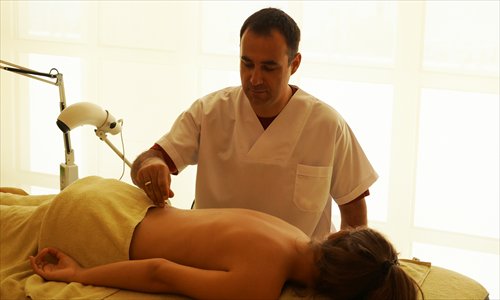
Igor Micunovic performs acupuncture on a patient at his clinic in Montenegro. (Photo/Courtesy of Igor Micunovic)
Lighting cotton balls in glass cups to create a vacuum and then putting them on the back of the prostrate patient one by one, the doctor's hands move quickly and with surety. He is administering cupping therapy, which would be an ordinary scene in clinics all around China, except that this particular doctor is a foreigner.
Cupping therapy is not new to doctor Igor Micunovic. In fact, the 38-year-old Montenegrin, who is currently doing a clinical internship at the First Teaching Hospital of Tianjin University of Traditional Chinese Medicine routinely administers cupping therapy to patients. In his independent clinical practice, he has seen various responses to cupping therapy, especially from Western patients.
"Oh, how long are the bruises going to last? I don't dare go sunbathing; people would think I am a victim of domestic violence," said one patient, who was accompanied by her husband.
"Well, just one to two years. Later the skin will peel off and revitalize itself over time," said Micunovic jokingly to the visibly shocked couple.
"I'm just joking; they might last several days or up to a week," he said, finally putting them at ease.
As the West wakes up to cupping therapy, bruising remains a major concern: spouses and parents of patients fear being accused of abuse.
A particularly serious incident happened in his hometown of Montenegro. The mother of his 6-year-old patient was accused of child abuse when she took her daughter to get vaccinated, and someone noticed her bruises. A hospital official had to call Micunovic to prove the mother's innocence.
Cupping therapy bruises propelled the traditional Chinese medicine (TCM) therapy technique onto the world stage recently when highly decorated American Olympic swimmer Michael Phelps sported them shortly after winning gold at the 2016 Rio Olympic Games in Brazil. Western media and social networks went wild with curiosity.
"What Are the Purple Dots on Michael Phelps? Cupping Has an Olympic Moment," said the headline of a New York Time blog on August 8. The post was accompanied by a 41 second video clip explaining why Olympians are turning to cupping therapy.
Phelps posted photos of himself during cupping therapy online. In an August 13 interview with CCTV, Phelps disclosed that he has been doing cupping for two or three years, and it is effective for him.
Coming to China in 2001, Micunovic is one of the growing number of foreigners who are learning and practicing TCM, eager to promote it to the world.
This group of foreigners are delighted that more people around the world are becoming familiar with TCM through the athletes at the Rio Olympics and are hopeful that there will be fewer misunderstandings about the medical practice.
For love of TCM
It was the efficacy of cupping in sports medicine that first attracted Micunovic. According to him, cupping promotes faster rehabilitation and gets rid of pain after a competition by improving the flow of qi (vital internal energy).
Micunovic came across TCM while reading for his master's degree in medicine at the University of Kragujevac in Serbia in 2000. Minoring in sports medicine at the time, Micunovic was instantly intrigued by TCM's rehabilitative properties when he came across it in a book.
"I was greatly inspired. I was an athlete myself, and I hoped to find more medical tools for faster rehabilitation and better sports performance," said Micunovic.
He was so taken by the subject that he left the University of Kragujevac and enrolled in Tianjin University of TCM. Micunovic's passion for TCM grew even further when he injured his foot during his first year in China.
He tried several modern Western treatments, but they didn't work, and his X-rays revealed nothing even though he was still suffering. Then he tried acupuncture, and after his first attempt, his pain was gone. The doctor who performed acupuncture on him later became his tutor and mentor.
Through his study of TCM and his own experience, Micunovic has achieved a deep understanding of TCM and its difference from Western medicine.
"Chinese medicine treats the human body as a unit and search for the disease's root and manifestations, but modern [Western] medicine treats only symptoms," he said. "A TCM doctor's diagnosis might predict and treat diseases at the very beginning, while modern [Western] medicine often finds sickness in a late phase."
Not everyone has a chance to gain an in-depth understanding of TCM like Micunovic. Even though TCM is gaining popularity overseas, it is not yet mainstream and people have varying understandings of what it is and how it works. Some are extremely skeptical, and they regard TCM as unscientific, a kind of folk medicine or even witchcraft.
But even as some Westerners denigrate TCM, other more pragmatic foreigners flock to it. People might be surprised by the overnight sensation of cupping therapy due to the Rio Olympics. But the fact that more and more foreign doctors have been heading to China to learn and practice TCM is a more powerful evidence of the influence and popularity of TCM, said Micunovic.


















































